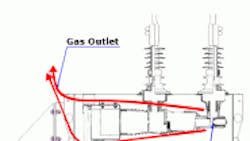Safer Solid Dielectric Arc Fault Contained AutoRecloser Video
April 16, 2010 -- Reclosers were first invented in the 1940s. They utilized oil interruption and oil insulation inside heavy mild steel tanks that contained faults in the event of internal arc faults.
The next generation of reclosers utilized SF6 gas which were contained inside pressure vessels which also contained arc faults in the event of internal faults.
Globally it is recognized that both oil and SF6 gas have undesirable environmental impact and the majority of utilities are eliminating their use in pole mounted switchgear today.
Thus solid dielectric switchgear has been invented and is available from a variety of recloser manufacturers today. However these products utilise solid dielectric technologies that do not provide arc fault containment and venting. From a safety perspective this is a backward step compared to previous generations in our view.
Today our electricity utilities are practising more live line installations and maintenance activities and require staff to approach energised switchgear more regularly.
It is therefore more important today than ever to have switchgear that is arc fault contained and vented in accordance with the requirements of IEC62271-200-2003 Clause 6.106 and Annex A.
The NOJA Power OSM range of reclosers which offer environmentally friendly solid dielectric installation have been designed and type tested to provide this important safety feature.
Arc Fault Containment Diagram
Arc fault containment testing conducted on the OSM200 Series product at Test & Certification Australia in Sydney 2009.
The NOJA Power OSM range of reclosers have successfully passed the arc fault containment type test and have complied to the 5 criterion below:
Criterion No. 1
Correctly secured doors and covers do not open.
Criterion No. 2
No fragmentation of the enclosure occurs within the time specified for the test.
Projections of small parts, up to an individual mass of 60 g.
Criterion No. 3
Arcing does not cause holes in the accessible sides up to a height of 2 m.
Criterion No. 4
Indicators do not ignite due to the effect of hot gases. Pictures taken by high-speed cameras, video or any other suitable means can be used by the test laboratory to establish evidence.
Criterion No. 5
The enclosure remains connected to its earthing point.
About the Author
Amy Fischbach
Field Editor
Amy Fischbach is the field editor for the Electric Utility Operations section of Transmission & Distribution World. She worked for Prism Business Media (now Penton) for eight years, most recently as the managing editor of Club Industry's Fitness Business Pro magazine. She is now working as a freelance writer and editor for B2B magazines. Amy earned her bachelor's and master's degrees in journalism from Kansas State University in Manhattan, Kansas. She serves as the national vice president of the American Society of Business Publication Editors. She can be reached at [email protected].
